




Abstract
Content
IntroductionGoals and оbjectives
Characteristics and influence of stationary and mobile sources of emissions to the atmospheric air in the city.
Analysis of existing internal combustion engines
Legal restrictions of emissions from motor vehicles
Evaluation of the implementation of European standards for vehicles
Conclusion
Literature:
Introduction
The high degree of urbanization, significant industrial potential, availability of enterprises belonging to the 1st class
of hazard, and located throughout the city of Donetsk, a high concentration of transport infrastructure, coupled with significant population densities
have created an enormous burden on the biosphere.
For Donetsk, as an industrial metropolis, the issues of air pollution are particularly relevant. According to the Ministry of Environmental
Protection, of the 53 cities that conducted monitoring of air quality at fixed positions, the city of Donetsk is one of five most polluted cities in
Ukraine.
The state of the air basin of Donetsk specifies the following:
- weather conditions, greatly affecting the transport and dispersion of harmful substances entering the atmosphere;
- socio-industrial complex, formed in the city and is characterized by specific emissions of harmful substances into the atmosphere.
Outdoor air pollution is one of the most serious environmental problems in many cities. Effects of air pollution on human health impact on
reducing life expectancy, increasing the number of premature deaths, increased incidence and negative impact on the younger generation.
The paper focuses on issues of air pollution by mobile sources of emissions because of their impact from year to year more and more essential.
Goals and оbjectives
The aim of this study is to assess the degree of influence of transport on the air of the city. We plan to perform such tasks as:
1. Analysis of the structure of vehicles in the city of Donetsk.
2. Analysis of the dynamics of pollutant emissions from mobile sources.
3. The calculation of the environmental performance for vehicles.
4. Assessing the possibility of implementing the requirements of Euro standards for road transport, on the basis of statistical data.
5. An analysis of motor currents in the central part of Voroshilov district (post-observation number 9).
6. Determination of concentrations of pollutants in different seasons.
7. The calculation of emissions in this sector of the city of vehicles of various kinds.
8. An analysis of possible measures to reduce the negative impact of vehicles on the urban environment.
Characteristics and influence of stationary and mobile sources of emissions to the atmospheric air in the city.
A characteristic feature of the economic complex of Donetsk is a diversified specialty industry, combined with well — developed transport and financial
management of the city. In industry, practically all sectors of the economy, however, the proportion of metals (both ferrous and nonferrous), coal,
chemical (including coke) industries and heavy engineering is the highest. Along with the traditional sectors of heavy industry in recent years developed
as light industry, food, woodworking, engineering.
Donetsk pass through the road of European, international and national importance. In the personal property of residents of the Donetsk region 714 000
cars. According to the Department of Public Relations General Directorate Ministry of Internal Affairs of Ukraine in Donetsk region, just as in 2009
recorded 779 000 800 units of vehicles. The greatest number of cars per unit area is marked in Donetsk, is graphically depicted in Picture 1.

Donetsk continues to lead the list of most polluted areas of the country. The largest share of methane (70%) in urban air
pollution are making mines, nitrous oxide — metals, boilers, waste heaps are burning, motor vehicles, especially imported from abroad — after a decade
there the operation. Within a few years of falling output and high — power installation of treatment facilities in large enterprises had to reduce the
harmful emissions into the atmosphere, but rather the air of the city has become even dirtier.
In contrast, significant changes were the situation on the roads of the city, the number of vehicles for several years has increased a
hundredfold. What visualized in Picture 2 the trend changes in the amount of emissions from stationary and mobile sources in the period from 1999 to 2008.
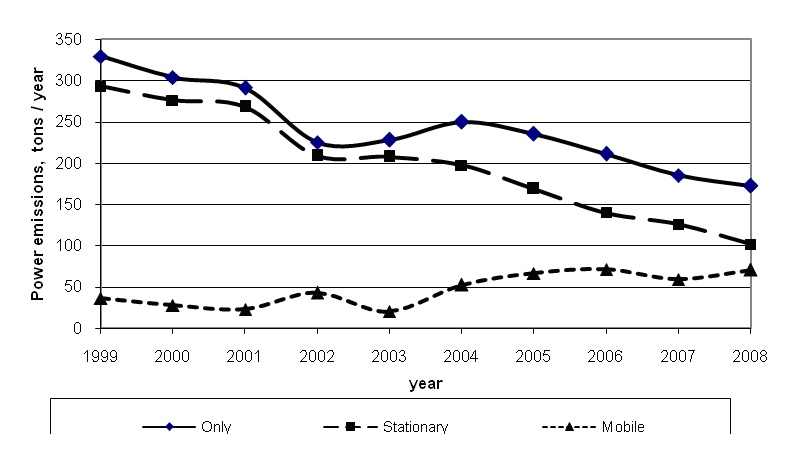
It is seen that for the period from 1999 to 2008 the increase in emissions of pollutants from motor vehicles occurred about
35 thousand tons in 2008, the contribution of motor vehicles amounted to almost 41% of total emissions in the city. While the reduction of pollutant
emissions from stationary sources was almost 67%. The above trend is stable, settled there about 2015, emissions from stationary and mobile sources will
be equal.
Analysis of the number and types of vehicles is shown in Pictures 3 and 4.
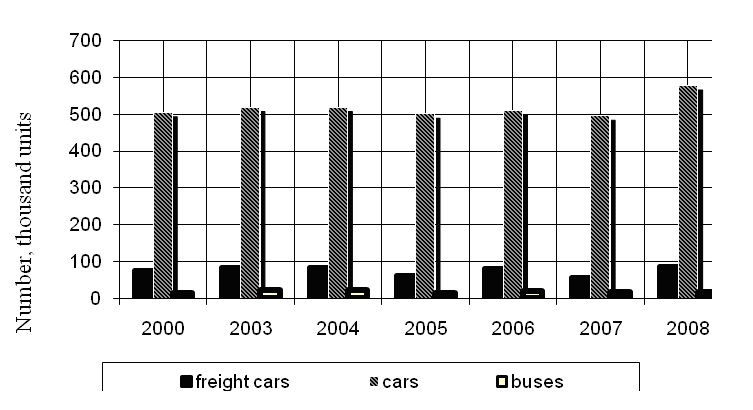
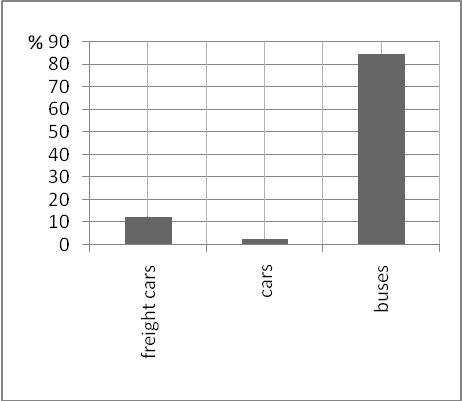
Analyzing the data on the species diversity of vehicles in the city of Donetsk, is clearly seen that 85% of the entire
fleet occupied cars. All the rest is commercial vehicles (12%) and passenger buses (3%).
Due to the growth of vehicle fleet has become increasingly manifest drawback of internal combustion engine, which was not previously
visible. When his work with the exhaust gases into the atmosphere come hundreds of pollutants. To reduce the negative impact of transport on the
environment to interfere with the operation of each car [2].
Analysis of existing internal combustion engines
Internal combustion engine (ICE) is called a heat engine in which the conversion of chemical energy of fuel into heat,
and then into mechanical energy takes place within the working cylinder. Conversion of heat into work in the engines associated with the implementation
of a set of complex physical, chemical, gas dynamic and thermodynamic processes that determine the different cycles and the design concept. The engines
are classified by the nature of the fuel on which the engine is running. Gaseous fuels for internal combustion engines are the natural, liquefied gas
and generator. Liquid fuels are petroleum products: gasoline, kerosene, diesel and other gas — liquid mixture to the engines are gaseous and liquid fuels,
with the main fuel is gaseous, and liquid is used as an igniter in small quantities. Flex — fuel vehicles capable of long run on different fuels ranging
from crude oil to high octane gasoline. The elemental composition of different fuels is given in table. 1.
| Fuel | Elemental composition,% (by weight) | ||||
| Wc | Wh | Wo | Wn | Ws | |
| Hydrogen | - | 100 | - | - | - |
| Compressed natural gas | 71 | 23,2 | 0,4 | 5,3 | 0,1 |
| Liquefied petroleum gas | 84 | 16 | - | - | 0,01 |
| Methanol | 37,5 | 12,5 | 50 | - | - |
| Dimetileter | 52,2 | 13 | 34,8 | - | - |
| Gasoline | 85,5 | 14,5 | - | - | 0,02 |
| Diesel fuel | 86,5 | 13,3 | - | 0,02 | 0,2 |
The same internal combustion engines are divided on how to fill the cylinder with fresh charge — to 4-stroke and
2 — stroke. By way of preparation of the combustible mixture of fuel and air — for engines with internal and external mixture formation. For engines with
external mixture formation include carburetor in which fuel — air mixture from liquid fuel and air is formed in the carburetor, and mixing, metering and in
which the combustible mixture of gas and air is formed in the mixer. In internal combustion engines with external mixture formation ignition of the
working mixture in the cylinder is an electric spark. In engines with internal mixture formation (diesel) fuel injected, it lights up when the compressed
air heated to high temperatures [3].
Conversion of chemical energy of fuel burnt in the cylinder, the mechanical work done by gaseous body — products of combustion of liquid or
gaseous fuels. Under pressure gas piston performs a reciprocating motion which is converted into rotational motion by the crankshaft of a crank mechanism
ICE.
In the combustion chamber of an automobile engine is a chemical compound of the elements that make up the fuel with oxygen from the air,
accompanied by intense heat, which is converted into work. For complete combustion of one kg of gasoline required for this process the stoichiometric
amount of air (14.8 kg). However, in milliseconds, allocated to the process of combustion in the cylinder, there is no complete mixing fuel with air and
combustion products that remain from the previous cycle to hamper access of oxygen to the fuel particles. As a result, not all the fuel has time to unite
with oxygen, and some of it in the form of toxic carbon monoxide and hydrocarbons emitted into the atmosphere.
The bulk of modern cars operate on fuel oil origin, consisting of a number of hydrocarbon compounds. Ideally, the exhaust gases must consist
of carbon dioxide, water vapor, nitrogen and other less hazardous substances. But in practice it is not. Table 2 presents data on the consumption of oxygen
and release carbon dioxide, water vapor, resulting in complete combustion.
| Fuel | Consumption O2 | Yield of substance | ||
| H2O | N2 | CO2 | ||
| Hydrogen | 7,94 | 8,94 | 26,41 | - |
| Compressed natural gas | 3,13 | 2,25 | 13,28 | 2,8 |
| Liquefied petroleum gas | 3,47 | 1,59 | 12 | 3 |
| Methanol | 1,5 | 1,13 | 4,98 | 1,37 |
| Dimetileter | 1,92 | 1,08 | - | 1,84 |
| Gasoline | 3,04 | 1,46 | 11,74 | 3,1 |
| Diesel fuel | 3,34 | 1,29 | 11,39 | 3,16 |
Incomplete combustion leads to the fact that in the exhaust gas contains more than 200 different chemicals, including:
• products of incomplete combustion in the form of carbon monoxide, aldehydes, ketones, hydrocarbons, hydrogen peroxide compounds, carbon black;
• the products of thermal reactions of nitrogen and oxygen — nitrogen oxides;
• inorganic compounds that make up the fuel — lead and other heavy metals, sulfur dioxide, etc.;
• excessive oxygen.
The number and composition of the exhaust gas mixture ratio determined by the air — fuel, the design of the engines, their mode of operation,
maintenance, quality of road surfaces, weather conditions [4].
Composition and emissions also depend on the type of engine. Table 3 shows data for a number of harmful substances emitted by motor gasoline
and diesel type.
| Substance | Engine type | |
| Petrol | Diesel | |
| Nitrogen | 74 - 77 | 76 - 78 |
| Oxygen | 0,3 - 8 | 2 - 18 |
| Water vapor | 3 - 5,5 | 0,5 - 4 |
| Carbon dioxide | 5 - 12 | 1 - 10 |
| Carbon monoxide | 5 - 10 | 0,01 - 0,5 |
| Nitrogen oxides | 0 - 0,8 | 0,0002 - 0,5 |
| Hydrocarbons | 0,2 - 3 | 0,009 - 0,5 |
| Aldehydes | 0 - 0,2 | 0,001 - 0,009 |
| Soot (g / m3) | 0 - 0,04 | 0,1 - 1,1 |
As can be seen from the table, emissions of major pollutants is much lower than in diesel engines. Therefore considered to
be of more environmentally friendly. However, diesel engines have higher emissions of soot due to refueling, which acts as an absorbent for carcinogenic
polycyclic aromatic hydrocarbons, including dioxins (cyclic ether) and benzo (a) pyrene, and lead and other compounds that belong to the first class of
hazard of pollutants substances.
In addition, work on diesel engines is characterized by certain modes of smokiness. Black smoke is a product of incomplete combustion and
consists of carbon particles (soot) with a size of 0.1-0.3 microns. The white smoke is produced mainly when the engine is idling, consists mainly of
aldehydes that are irritating to the evaporating fuel particles and water droplets. Blue smoke is generated by cooling the air exhaust. It consists of
droplets of liquid hydrocarbons.
Road transport is not only pollutes the air. Roadside area contaminated products tire wear, anti-friction materials and pavement. Straits
of lubricants, fuels and fluids contaminate soil, and only 300 grams of gasoline spilled during refueling of the car, pollute the 200 000 cubic meters
of air [5].
Legal restrictions of emissions from motor vehicles
The first steps to limit the amount of harmful substances in exhaust gases were made in the United States, where the issue
of gas concentration in large cities has become acute after World War II. In the late 60s, when the mega-cities of America and Japan began to choke on the
smog, the initiative was taken to a government commission of these countries. Legislative acts of the mandatory reduction of toxic emissions of new cars
forced manufacturers to do the improvement and development of engine systems neutralization.
In 1970, the United States passed a law under which the level of toxic components in exhaust gases of vehicles in 1975 model year would be
less than that of cars in 1960 production: CH — 87%, C — 82% and NOx — on 24%. Similar requirements have been legalized in Japan and Europe.
The development of European rules, regulations and standards for environmental vehicles engaged in operating within the United Nations
Economic Commission for Europe (UNECE) Inland Transport Committee. Documents they produce are called the UNECE Regulations and are obligatory for member
countries of the Geneva Agreement of 1958.
Under these rules, the allowable emissions of harmful substances in 1993 were limited to: carbon monoxide by 15 g / km in 1991 to 2.2 g / km
in 1996, and the sum of hydrocarbons and oxides of nitrogen and 5.1 g / km in 1991 to 0.5 g / km in 1996. In 2000 introduced more stringent rules. The
sharp tightening of standards is also provided for the diesel trucks.
Norms introduced for cars in 1993, called EBPO-I, in 1996 — EURO-II, in 2000 — EURO-III. The introduction of these standards has brought the
European rules on the level of U.S. standards.
Along with the quantitative standards are more stringent and quality change. Instead, the restrictions imposed on the valuation of smoke
particulates, which are adsorbed on the surface dangerous for human health aromatic hydrocarbons, particularly benzo (a) pyrene.
Normalization of particulate emissions limits their number to a much greater extent than under the constraint of smoke that measure only the
amount of particulate matter, which makes the exhaust gases are visible.
In order to limit the emissions of toxic hydrocarbons, introduced rules on the content of the exhaust gases bezmetanovoy of
hydrocarbons. Planned to introduce restrictions on the release of formaldehyde. Provision to control vapors from the fuel feed system cars with gasoline
engines. Picture 5 shows a comparison of all classes of the Euro, the concentration of pollutants in the exhaust gases of vehicles.
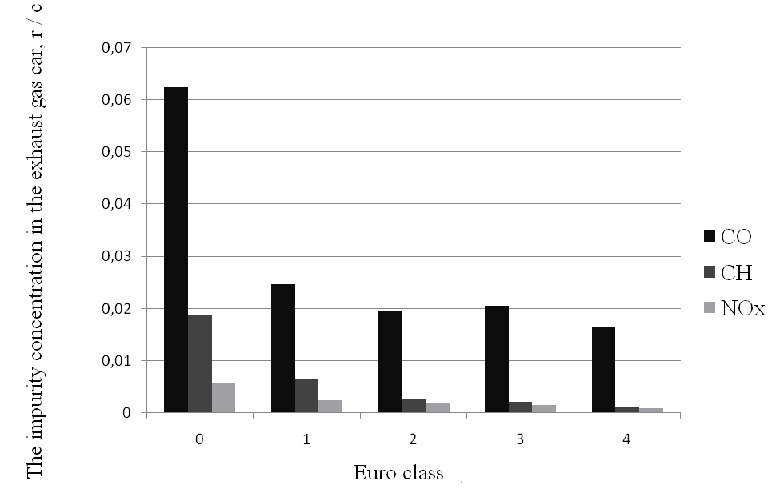
According to these standards by comparing the introduction of the Euro is very important to reflect on the state of urban
air. As in the U.S. and in UNECE Regulations are governed by vehicle miles traveled (80 thousand and 160 thousand kilometers), during which they must
conform to established standards for toxicity.
The system of emission control exhaust gases of automobile engines establishes emission standard to be met by vehicles sold in EU
countries. "Most old rules" of toxicity, Euro 1, applicable to both new and used cars, entered into force in 1993. To the old machine to meet these
requirements, they began to install catalytic converters already in use. If the car owner did not do it such heavy taxes levied on cars.
Since 1996, the enacted emission standard Euro 2. In order to "fit" in the new rules, carmakers have gone over to the point of injection,
where each cylinder has its own nozzle. In addition, the engine began to run the perfect electronic "brain", which accurately meters the fuel supply.
More stringent Euro 3 came into effect in 2000. They regulate the exhaust emissions and engine warm-up mode. Earlier exhaust checked after
engine warm up above 40 ° C and Euro 3 in the last edition — with minus 7 ° C. As for the level of toxicity is largely "responsible for" catalyst,
efficient only after warming up, its closer to the exhaust manifold or equipped with heating. Incidentally, some manufacturers have started to do it with
a layer of insulation, double — layer or composite materials, thus reducing heat loss. At this stage also begun introducing direct fuel injection systems,
ie directly into the cylinders, which allowed a partial load mode to achieve mixing and layering work pereistoschennyh mixtures
(engines GDI, D4, FSI, etc.). There were also the EGR and in diesel engines — particulate filter (FAP), capable of self — cleaning and replaced.
Euro 4 comes into force on 1 January 2006. For diesel engine cars are these requirements not only limit the emissions of soot (PM) to 0.025
g / km of carbon dioxide (CO2), but also reduce the maximum allowable level of emissions of carbon monoxide (CO) and 0.50 g / km and nitrogen dioxide (NO2)
and 0.25 g / km (Euro 3 requirements applicable — 0.95 g / km and 0.78 g / km, respectively). In Euro 4, but the new rules as other test methods. Toxicity
is controlled not only by the permanent steady — state conditions, but also on the transition — for example, by pressing on the gas pedal (simulation
acceleration) or when you reset the gas (engine braking).
However, the Ukrainian standards significantly behind the UNECE standards. The reasons for the lag — lack of training infrastructure,
operation of automotive equipment. For prevention, repair and maintenance of vehicles equipped with electronic systems and neutralization, we need
well — developed network of service stations with qualified personnel, modern repair equipment and instrumentation, including in the field.
Formally, the norm in Ukraine Euro 2 introduced in 2002 by orders of the Ministry of Transport and GOST. There is a Law of Ukraine № 2134-III
dated December 7, 2000 "On Amendments to Certain Legislative Acts of Ukraine on regulation of the vehicles Ukraine." One of its paragraphs states that our
country is forbidden to import cars without a catalytic converter, which provides the content of harmful substances in exhaust gases at the level of
Euro 2. But this formulation is not entirely correct. The law should not be guidelines for the design of the car. If the normalized amount of harmful
emissions, it should appear in the document. In fact, the law at the state level is not satisfied.
However, the Euro 2 standards have already been introduced and the State Standard. May 4, 2005 the Ministry of Justice registered the order
according to which from 1 January 2006 in Ukraine will not be able to import, sell and register vehicles that do not meet Euro 2.
Environmental restrictions will not apply to imported, released and registered vehicles. They can still be exploited. It is worth noting that
the cars of the Soviet era do not meet any Euro. Moreover, if you need to equip them with catalytic converters, there is a serious problem, as to combine
the characteristics of carburetors and requirements of catalysts is very difficult.
Another big problem in Ukraine regards the fuel. By 2008, the situation with the marking of gasoline has been mixed. Most gasoline with
prefixes Euro, Premium, Super and Plus 95-octane match on the research method and by this indicator similar to the A-95 (Au-95). As for consoles, the
situation was as follows:
Gasoline A-95 Plus (+), such as a gas station "UkrAVTO" differed from the usual A-95 (Au-95) in the presence of detergent additives is
necessarily included in the European gasoline. Accordingly, the fuel has better cleaning properties and effectively protects the nozzles, valves, and
the entire fuel system from varnish and unwanted deposits. This prolongs the life of the fuel system and vehicle.
Relative to the other, it can be commercially known as gasoline, for example, Super. One by one name, without assessing performance of
gasoline and a passport quality is difficult to determine its properties.
Sometimes the name of gasoline, for example, Shell V-Power, Formula (UkrTatNafta), may indicate their specific quality indicators.
According to the standard EN 228:2004 in Premium gasoline octane number is governed by national standards (ie, it can be 92, 95, etc.). Classes
are set fumes: A, B, C/C1, D/D1, E/E1, F/F1 (depending on weather conditions). In Ukraine, may get fuel unsuitable for our climate, for example, the
initial boiling point (for our country, it must comply with Class B or Class 1 — to EN: 228:1993). Therefore, no additional information on gasoline is
difficult to assess its quality in name only Premium.
A similar situation was before and with the prefix Euro — no extra information it is impossible to assess the quality of fuel, because the
standard EN 228 (which indicates the name of the Euro) has in its designation of the year of his administration. Gasoline may issue Euro standard EN
228:1993, EN 228:1996, EN 228:1999 or EN 228:2004. Gasoline produced by the old standards EN 228:1993, EN 228:1996, EN 228:1999, the quality differs
from gasoline, which comes standard EN 228:2004 (in particular, EN 228:2004, imposes higher requirements on the content sulfur, the presence of detergent
additives to the absence of metal — containing additives, the content of aromatic hydrocarbons in the fuel, etc.). So petrol Euro without specifying the year
before the standard could not be considered better quality A-95.
From 1 January 2009 Ukraine introduced new standards for "Gasoline for automobiles of higher quality" and "Diesel fuel is higher quality,"
meeting the requirements of Euro 3 and Euro 4. This fuel is marked with the prefix Euro (eg GP Euro, A-95 Euro). By 2011 the first new standards will
operate in parallel with the old. This is explained by the need to upgrade a number of naftopereroblyuyuchih plants (refineries), which are not yet able
to produce petroleum products of such quality. Fuel standards Euro 3 and Euro 4 Lisichanskiy produces only oil refinery, and will soon begin production
and the Odessa refinery. Most of gasoline on the European standards are imported from abroad, such as petrol stations sold fuel CLAUD Euro 4 and Euro 5,
which also has a different trade name of - respectively the "Super" and "Premium." Incidentally, the official Euro 5 is scheduled for introduction in
October 2009. The main requirements formulated by him, but not yet officially introduced and approved. Also worth noting is that the requirements of
Euro 4 provide production as gasoline with sulfur content 50 ppm (0,005%), and gasoline with sulfur content of 10 ppm (0,001%), which is the intermediate
stage of transition to Euro 5.
Evaluation of the implementation of European standards for vehicles, for example, the central part of the Voroshilov district of Donetsk
According to the methodology approved by the State Statistics Committee of Ukraine, an analysis of traffic in the area
bounded by Avenue B. Khmelnitsky Str. Artem Ave Vatutina and Str. Chelyuskintsev during peak hours. The observation results are shown in table 4.
| Name of car | pr. B.Khmelnitsky | st. Artem | Pr.Vatutina | st. Chelyuskintsev | Only |
| Passenger transport home | 214 | 173 | 54 | 148 | 589 |
| Passenger transport overseas | 472 | 631 | 176 | 290 | 1569 |
| Minivans and vans | 118 | 59 | 15 | 36 | 228 |
| Trucks gasoline (> 3,5 t) | 2 | 0 | 3 | 5 | 10 |
| Buses gasoline | 7 | 11 | 0 | 5 | 23 |
| Diesel buses | 2 | 0 | 0 | 0 | 2 |
| Diesel trucks> 12 tons | 0 | 0 | 1 | 10 | 11 |
Analysis of traffic flow shows that most of it in the central part of the city is passenger vehicles (almost 90%), due to
the partial restriction map of trucks, equipment and a large network of bypass roads for him.
To reduce the negative impact of transport on the air and human health should be the main introduction of Euro standards. Possible changes
in the implementation of rules on the example of Voroshilov district, can be estimated using the complex index — the category of dangerous vehicle (CDV)
on Bondarenko EV Dvornikov and GP, which integrates both the amount of emissions of all the impurities contained in the exhaust gas, as well as their
hazard class and toxicity.
In this paper we have calculated the index of environmental performance for all traffic flows considered site. When calculating environmental
performance into account the following pollutants: carbon monoxide, hydrocarbons, carbon oxides in terms of NO2, particulate matter in terms of
carbon (PM), sulfur dioxide, methane, non — methane hydrocarbons (NMVOC) and ammonia.
The evaluation was conducted for the norms of Euro-0 — Euro-3 according to the formula:
where ai — dimensionless constant, which allows to correlate the degree of harmfulness of the i-th substance with the harmfulness of sulfur dioxide (III hazard class);
PACi — maximum single-maximum allowable concentration of the i-th substance, g/m3;
Mi — emissions of the i-th impurity in the atmosphere, g / sec.
The results of the analysis of risk factor are presented as in picture 4.
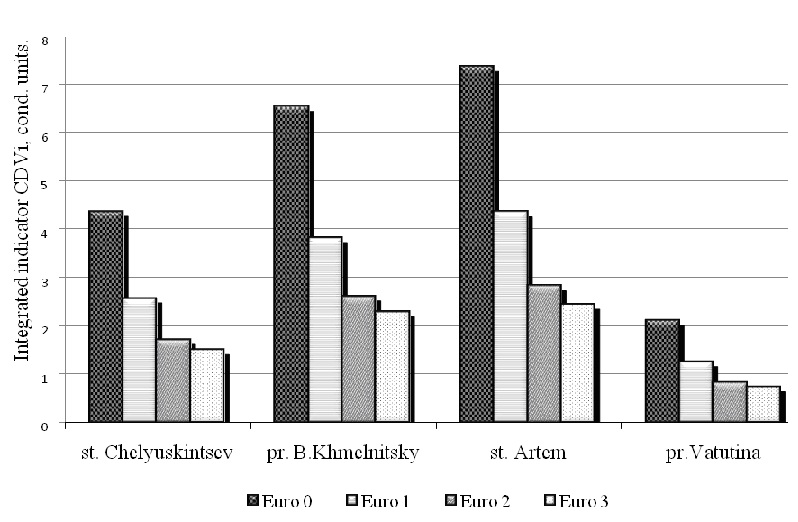
Chart analysis shows that the introduction of Euro for cars on Ukrainian territory, and for the city of Donetsk in particular, significantly reduced the danger of vehicles on the environment. The actual implementation of Euro-3 in the city of Donetsk will reduce the risk of passenger transport by 4.5 times, and the cargo — nearly 2 times, which in turn will lead to a reduction of pollutant emissions from mobile sources.
Conclusion
To reduce the negative impact on air transport and urban public health leadership must take steps to re-route traffic,
construction of new roads and restrict the entry of trucks and transit buses in the city center. In addition, the principal should be the introduction of
the Euro standards. Among the developments that will be required in connection with the transition to the Euro standards, may provide such basic as the
installation of catalytic converters, improved fuel quality improvement and renewal of the public transport industry. Given that most of the vehicles are
privately owned, the introduction of improvements in accordance with the standards of the Euro, will need to consider the social aspect. Lower standard of
living of Ukrainians, compared with the population of Europe will not allow many of the people of Donetsk to allocate the necessary funds to bring their
cars to the Euro.
In writing this essay master's work is not finished yet. The final conclusion in December 2011 Full text of the materials on the subject can
be granted by the author or his manager after that date.
Literature:
-
http://www.lukyanchenko.donetsk.ua/public_echo.php?id=276
Доклад о состоянии окружающей природной среды города Донецка в 2000 году. Донецкий городской совет управление экологической безопасности, 2000.
-
Денисов В.Н., Рогалев В.А. Проблемы экологизации автомобильного транспорта. Изд. 2-ое. — СПб.: МАНЭБ, 2004. - 312 с.
-
Вырубов Д. Н., Алексеев В. П. Двигатели внутреннего сгорания, т. 1 -3, М., 1957-62.
-
Павлова А.И. Экология транспорта: Учебник для вузов. — М.: Транспорт, 2000. — 248 с.
-
Иванов В.Н., Сторчевус В.К., Доброхотов В.С. Экология и автомобилизация. — Киев: Будiвельник, 1983.
-
Бондаренко Е.В., Дворников Г.П. Б-81. Дорожно–транспортная экология: Учебное пособие/под ред. А.А. Цыцуры. — Оренбург: ГОУ ОГУ, 2004. — 113 с.
-
Расчетная инструкция по инвентаризации выбросов загрязняющих веществ автотранспортными средствами в атмосферный воздух. М.: НИИАТ, 2006.